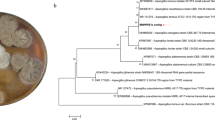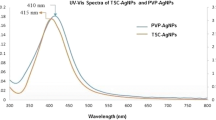Abstract
In the present study, we report enhanced antimicrobial properties of 29 and 23 nm silver nanoparticles (Ag NPs) obtained by electrochemical synthesis in poly(amide-hydroxyurethane) media. Antibacterial activity assessed by disk diffusion method indicates that silver nanoparticles produced inhibition zones for both Escherichia coli and Staphylococcus aureus depending on silver concentration. The bacterial growth curve performed in the presence of silver nanoparticles showed a stronger antibacterial effect at lower concentrations than those described in the earlier reports. The effect was both dose and size dependent and was more pronounced against Gram negative bacteria than Gram positive one. The smallest Ag NPs used had a bactericidal effect resulting in killing E. coli cells. Scanning electron microscopy analysis indicated major damage and morphology changes of the silver nanoparticles treated bacterial cells. The major mechanism responsible for the antibacterial effect probably consists in clusters formation and nanoparticles anchorage to the bacterial cell surface.







Similar content being viewed by others
References
Rai M, Yadav A, Gade A. Silver nanoparticles as a new generation of antimicrobials. Biotechnol Adv. 2009;27(1):76–83. doi:10.1016/j.biotechadv.2008.09.002..
Kim JS, Kuk E, Yu KN, Kim J-H, Park SJ, Lee HJ, et al. Antimicrobial effects of silver nanoparticles. Nanomed-Nanotechnol Biol Med. 2007;3(1):95–101.
Pal S, Tak YK, Song JM. Does the antibacterial activity of silver nanoparticles depend on the shape of the nanoparticle? A study of the gram-negative bacterium Escherichia coli. Appl Environ Microbiol. 2007;73(6):1712–20. doi:10.1128/aem.02218-06.
Gong P, Li H, He X, Wang K, Hu J, Tan W, et al. Preparation and antibacterial activity of Fe3O4@Ag nanoparticles. Nanotechnology. 2007;18(28):285604.
Shrivastava S, Bera T, Roy A, Singh G, Ramachandrarao P, Dash D. Characterization of enhanced antibacterial effects of novel silver nanoparticles. Nanotechnology. 2007;18(22):225103. doi:10.1088/0957-4484/18/22/225103.
Duran N, Marcarto PD, De Souza GIH, Alves OL, Esposito E. Antibacterial effect of silver nanoparticles produced by fungal process on textile fabrics and their effluent treatment. J Biomed Nanotechnol. 2007;3:203–8.
Egorova EM, Revina AA, Rostovshchikova TN, Kiseleva OI. Bactericidal and catalytic properties of stable metal nanoparticles in reverse micelles. Vestn Mosk Univ Ser 2 Khim. 2001;42(5):332–8.
Morones JR, Elechiguerra JL, Camacho A, Holt K, Kouri JB, Ramirez JT, et al. The bactericidal effect of silver nanoparticles. Nanotechnology. 2005;16(10):2346–53. doi:10.1088/0957-4484/16/10/059.
Martínez-Castañón G, Niño-Martínez N, Martínez-Gutierrez F, Martínez-Mendoza J, Ruiz F. Synthesis and antibacterial activity of silver nanoparticles with different sizes. J Nanopart Res. 2008;10(8):1343–8.
Zhao GJ, Stevens SE. Multiple parameters for the comprehensive evaluation of the susceptibility of Escherichia coli to the silver ion. Biometals. 1998;11(1):27–32.
Marini M, De Niederhausern S, Iseppi R, Bondi M, Sabia C, Toselli M, et al. Antibacterial activity of plastics coated with silver-doped organic-inorganic hybrid coatings prepared by sol-gel processes. Biomacromolecules. 2007;8(4):1246–54. doi:10.1021/bm060721b.
Castellano JJ, Shafii SM, Ko F, Donate G, Wright TE, Mannari RJ, et al. Comparative evaluation of silver-containing antimicrobial dressings and drugs. Int Wound J. 2007;4(2):114–22. doi:10.1111/j.1742-481X.2007.00316.x.
Tang SC, Tang YF, Gao F, Liu ZG, Meng XK. Ultrasonic electrodeposition of silver nanoparticles on dielectric silica spheres. Nanotechnology. 2007;18(29):295607. doi:10.1088/0957-4484/18/29/295607.
Melnig V, Pohoata V, Obreja L, Garlea A, Cazacu M. Water-soluble polyamidhydroxyuretane swelling behaviour. J Optoelectron Adv Mater. 2006;8:1040–3.
Obreja L, Dorohoi DH, Melnig V, Foca N, Nastuta A. Poly(amidehydroxyurethane) templated Fe3O4 and Ag nanoparticles galvanostatic assay synthesis. Mater Plast. 2008;3(45):261–4.
Riddick TM. Control of colloid stability through zeta-potential. New York: Livingston Publishing Co; 1968.
Lorian V. Antibiotics in laboratory medicine. 5th ed. Philadelphia: Lippincott Williams & Wilkins; 2005.
Stoimenov PK, Klinger RL, Marchin GL, Klabunde KJ. Metal oxide nanoparticles as bactericidal agents. Langmuir. 2002;18(17):6679–86.
Marambio-Jones C, Hoek EMV. A review of the antibacterial effects of silver nanomaterials and potential implications for human health and the environment. J Nanopart Res. 2010;12(5):1531–51. doi:10.1007/s11051-010-9900-y.
Sondi I, Salopek-Sondi B. Silver nanoparticles as antimicrobial agent: a case study on E. coli as a model for Gram-negative bacteria. J Colloid Interface Sci. 2004;275:177–82.
Cho K-H, Park J-E, Osaka T, Park S-G. The study of antimicrobial activity and preservative effects of nanosilver ingredient. Electrochim Acta. 2005;51(5):956–60.
Tortora J, Case CL, Funke BR. Microbiology: an introduction. 7th ed. San Francisco: Benjamin Cummings; 2002.
Rupp ME, Fitzgerald T, Marion N, Helget V, Puumala S, Anderson JR, et al. Effect of silver-coated urinary catheters: efficacy, cost-effectiveness, and antimicrobial resistance. Am J Infect Control. 2004;32(8):445–50. doi:10.1016/S0196655304004742.
Panácek A, Kolár M, Vecerová R, Prucek R, Soukupová J, Krystof V, et al. Antifungal activity of silver nanoparticles against Candida spp. Biomaterials. 2009;30(31):6333–40.
Lok CN, Ho CM, Chen R, He QY, Yu WY, Sun HZ, et al. Proteomic analysis of the mode of antibacterial action of silver nanoparticles. J Proteome Res. 2006;5(4):916–24. doi:10.1021/Pr0504079.
Lee D, Cohen RE, Rubner MF. Antibacterial properties of Ag nanoparticle loaded multilayers and formation of magnetically directed antibacterial microparticles. Langmuir. 2005;21(21):9651–9. doi:10.1021/la0513306.
Thiel J, Pakstis L, Buzby S, Raffi M, Ni C, Pochan DJ, et al. Antibacterial properties of silver-doped titania13. Small. 2007;3(5):799–803.
Kvitek L, Panacek A, Soukupova J, Kolar M, Vecerova R, Prucek R, et al. Effect of surfactants and polymers on stability and antibacterial activity of silver nanoparticles (NPs). J Phys Chem C. 2008;112(15):5825–34. doi:10.1021/jp711616v.
Matsumura Y, Yoshikata K, Kunisaki S, Tsuchido T. Mode of bactericidal action of silver zeolite and its comparison with that of silver nitrate. Appl Environ Microbiol. 2003;69(7):4278–81. doi:10.1128/Aem.69.7.4278-4281.2003.
Braydich-Stolle L, Hussain S, Schlager JJ, Hofmann MC. In vitro cytotoxicity of nanoparticles in mammalian germline stem cells. Toxicol Sci. 2005;88(2):412–9. doi:10.1093/toxsci/kfi256.
Acknowledgments
This study was supported by CNCSIS–UEFISCSU, 509 PNII–IDEI 1996/2008 research grant.
Author information
Authors and Affiliations
Corresponding author
Additional information
An erratum to this article can be found at http://dx.doi.org/10.1007/s10856-011-4360-1
Rights and permissions
About this article
Cite this article
Marius, S., Lucian, H., Marius, M. et al. Enhanced antibacterial effect of silver nanoparticles obtained by electrochemical synthesis in poly(amide-hydroxyurethane) media. J Mater Sci: Mater Med 22, 789–796 (2011). https://doi.org/10.1007/s10856-011-4281-z
Received:
Accepted:
Published:
Issue Date:
DOI: https://doi.org/10.1007/s10856-011-4281-z




